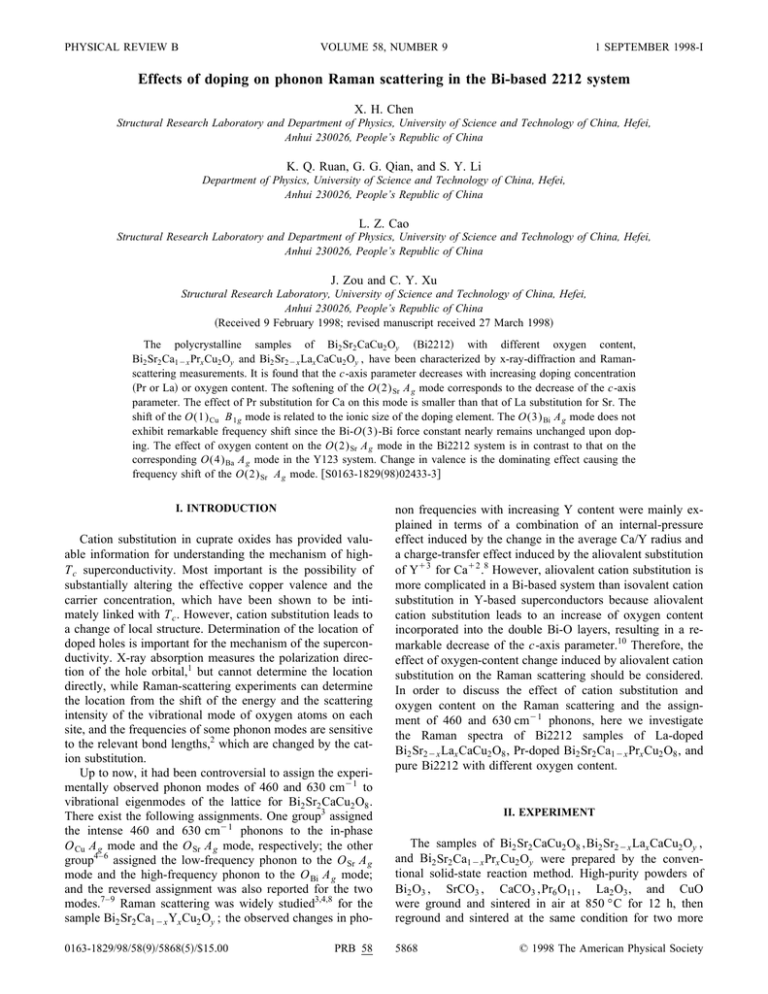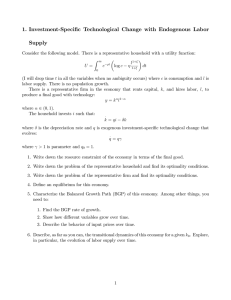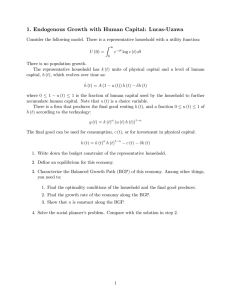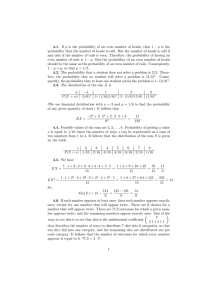Effects of doping on phonon Raman scattering in the Bi-based... X. H. Chen
advertisement

PHYSICAL REVIEW B VOLUME 58, NUMBER 9 1 SEPTEMBER 1998-I Effects of doping on phonon Raman scattering in the Bi-based 2212 system X. H. Chen Structural Research Laboratory and Department of Physics, University of Science and Technology of China, Hefei, Anhui 230026, People’s Republic of China K. Q. Ruan, G. G. Qian, and S. Y. Li Department of Physics, University of Science and Technology of China, Hefei, Anhui 230026, People’s Republic of China L. Z. Cao Structural Research Laboratory and Department of Physics, University of Science and Technology of China, Hefei, Anhui 230026, People’s Republic of China J. Zou and C. Y. Xu Structural Research Laboratory, University of Science and Technology of China, Hefei, Anhui 230026, People’s Republic of China ~Received 9 February 1998; revised manuscript received 27 March 1998! The polycrystalline samples of Bi2 Sr2 CaCu2 Oy ~Bi2212! with different oxygen content, Bi2 Sr2 Ca12x Prx Cu2 Oy and Bi2 Sr22x Lax CaCu2 Oy , have been characterized by x-ray-diffraction and Ramanscattering measurements. It is found that the c-axis parameter decreases with increasing doping concentration ~Pr or La! or oxygen content. The softening of the O(2) Sr A g mode corresponds to the decrease of the c-axis parameter. The effect of Pr substitution for Ca on this mode is smaller than that of La substitution for Sr. The shift of the O(1) Cu B 1g mode is related to the ionic size of the doping element. The O(3) Bi A g mode does not exhibit remarkable frequency shift since the Bi-O(3)-Bi force constant nearly remains unchanged upon doping. The effect of oxygen content on the O(2) Sr A g mode in the Bi2212 system is in contrast to that on the corresponding O(4) Ba A g mode in the Y123 system. Change in valence is the dominating effect causing the frequency shift of the O(2) Sr A g mode. @S0163-1829~98!02433-3# I. INTRODUCTION Cation substitution in cuprate oxides has provided valuable information for understanding the mechanism of highT c superconductivity. Most important is the possibility of substantially altering the effective copper valence and the carrier concentration, which have been shown to be intimately linked with T c . However, cation substitution leads to a change of local structure. Determination of the location of doped holes is important for the mechanism of the superconductivity. X-ray absorption measures the polarization direction of the hole orbital,1 but cannot determine the location directly, while Raman-scattering experiments can determine the location from the shift of the energy and the scattering intensity of the vibrational mode of oxygen atoms on each site, and the frequencies of some phonon modes are sensitive to the relevant bond lengths,2 which are changed by the cation substitution. Up to now, it had been controversial to assign the experimentally observed phonon modes of 460 and 630 cm21 to vibrational eigenmodes of the lattice for Bi2 Sr2 CaCu2 O8 . There exist the following assignments. One group3 assigned the intense 460 and 630 cm21 phonons to the in-phase O Cu A g mode and the O Sr A g mode, respectively; the other group4–6 assigned the low-frequency phonon to the O Sr A g mode and the high-frequency phonon to the O Bi A g mode; and the reversed assignment was also reported for the two modes.7–9 Raman scattering was widely studied3,4,8 for the sample Bi2 Sr2 Ca12x Yx Cu2 Oy ; the observed changes in pho0163-1829/98/58~9!/5868~5!/$15.00 PRB 58 non frequencies with increasing Y content were mainly explained in terms of a combination of an internal-pressure effect induced by the change in the average Ca/Y radius and a charge-transfer effect induced by the aliovalent substitution of Y13 for Ca12 .8 However, aliovalent cation substitution is more complicated in a Bi-based system than isovalent cation substitution in Y-based superconductors because aliovalent cation substitution leads to an increase of oxygen content incorporated into the double Bi-O layers, resulting in a remarkable decrease of the c-axis parameter.10 Therefore, the effect of oxygen-content change induced by aliovalent cation substitution on the Raman scattering should be considered. In order to discuss the effect of cation substitution and oxygen content on the Raman scattering and the assignment of 460 and 630 cm21 phonons, here we investigate the Raman spectra of Bi2212 samples of La-doped Bi2 Sr22x Lax CaCu2 O8 , Pr-doped Bi2 Sr2 Ca12x Prx Cu2 O8 , and pure Bi2212 with different oxygen content. II. EXPERIMENT The samples of Bi2 Sr2 CaCu2 O8 ,Bi2 Sr22x Lax CaCu2 Oy , and Bi2 Sr2 Ca12x Prx Cu2 Oy were prepared by the conventional solid-state reaction method. High-purity powders of Bi2 O3 , SrCO3 , CaCO3 ,Pr6 O11 , La2 O3 , and CuO were ground and sintered in air at 850 °C for 12 h, then reground and sintered at the same condition for two more 5868 © 1998 The American Physical Society PRB 58 EFFECTS OF DOPING ON PHONON RAMAN . . . 5869 FIG. 1. Lattice parameters for Bi2 Sr2 Ca12x Prx Cu2 O81 d ~squares! and Bi2 Sr22x Lax CaCu2 O81 d ~circles! vs the dopant ~Pr and La! content. times. Finally, they were ground again and pressed into pellets and calcined at a temperature between 850 and 930 °C for 72 h, and cooled to room temperature by an air furnace. In order to obtain the samples with different oxygen content, the as-prepared samples of Bi2 Sr2 CaCu2 O8 were annealed at 500 °C in the nitrogen and oxygen flow, respectively. The obtained samples were characterized by x-ray powder diffraction with Cu K a radiation. Lattice parameters for singlephase materials were refined using the Bragg peaks over the u range. Raman spectra were measured on a Spex-1403 Raman spectrophotometer using a backscattering technique. The 5145-Å line from the argon ion laser was used as an excitation light source. All measurements were made at room temperature, and each spectrum shown was taken with refocusing on at least two different spots to assure reproducibility. The resolution of Raman spectra was 3 cm21 and the laser spot size on the samples was about 1 mm. III. RESULTS AND DISCUSSION X-ray-diffraction patterns can be indexed with a tetragonal lattice for the samples of Bi2 Sr2 CaCu2 O8 , Bi2 Sr22x Lax CaCu2 O8 , and Bi2 Sr2 Ca12x Prx Cu2 Oy (x<0.5) systems, while the samples of Bi2 Sr2 Ca12x Prx Cu2 Oy (x.0.5) were indexed with an orthorhombic lattice due to a splitting of the ~200! peak observed in x-ray diffraction. A similar phenomenon has been observed in the Y-doped Bi2212 system. It suggests that the samples are a single Bi2212 phase. The dopant content dependence of lattice parameters is plotted in Fig. 1. It shows a monotonous decrease in the c axis with substituting both Pr31 for Ca21 and La31 for Sr21 , but the a-axis parameter shows an opposite trend. The length of the a axis is considered to be controlled by the in-plane Cu-O bond distance, which is closely related to the carrier concentration. The increase in the a-axis parameter arises from the decrease of hole concentration that weakens the Cu-O bonding when dopant content is increased. It should be expected that the c-axis lattice parameter slightly increases when Ca is replaced by Pr31 (r e f f 51.126 Å), since Ca21 has only an ionic radius of r e f f 51.12 Å. But the c-axis parameter decreases by 0.047 nm on going from Bi2 Sr2 CaCu2 O81 d to the Bi2 Sr2 PrCu2 O81 d . It could arise from the increase of excess oxygen incorporated between the Bi2 O2 double layers induced by aliovalent substitution. One FIG. 2. Room-temperature Raman spectra for the samples of the Bi2 Sr2 Ca12x Prx Cu2 O81 d system. possible explanation11 for the relation between the c-axis length and oxygen content is that extra oxygen incorporated into the BiO layers leads to a change of the orientation of the Bi31 lone pair, which causes a decrease of the distance of the two adjacent BiO layers. Another explanation12 is that the net positive charge and hence the repulsion between the Bi2 O2 layers decrease, causing the slab sequence, SrO-BiOBiO-SrO, to shrink. The c-axis parameters are 3.0694 and 3.0817 nm for the pure Bi2212 samples annealed at 500 °C in O2 and N2 , respectively. It directly indicates that reduction of the pure Bi2212 sample leads to an increase of the c-axis lattice parameter, which is consistent with the previous reports.13,14 Figure 2 shows the Raman spectra of the Bi2 Sr2 Ca12x Prx Cu2 Oy (x50.2, 0.4, 0.6, and 1.0! in the frequency range of 200–800 cm21 at room temperature. In Fig. 2, four Raman modes at 290, 464, 630, and 660 cm21 were clearly observed within this frequency range. The 290- and 660-cm21 modes have been identically assigned to the B 1g mode of vibration of O(1) Cu atoms along the c axis and to the vibration of extra oxygen within the Bi2 O2 layers, respectively. The mode at 464 cm21 remains essentially constant with increasing Pr content, while the 630-cm21 mode changes significantly as a function of Pr concentration, and softens at about 12 cm21 in going from Bi2 Sr2 CaCu2 O81 d to Bi2 Sr2 PrCu2 O81 d . The B 1g O(1) Cu phonon is directly related to the atoms in the conducting CuO2 planes. Its intensity increases with decreasing metallicity ~increasing x) as seen in Fig. 2. The similar behavior has also been observed for the corresponding vibrations related to the CuO2 planes in YBa2 Cu3 O61 d ~Ref. 15! and Bi2 Sr2 Ca12x Yx Cu2 O81 d .8 These effects are direct manifestations of the decrease in the number of charge carriers induced by doping. The decrease of holes induced by doping leads to a reduced metallic screening both within and between adjacent CuO2 planes, leading to larger CuO2 bond 5870 CHEN, RUAN, QIAN, LI, CAO, ZOU, AND XU PRB 58 FIG. 3. Room-temperature Raman spectra for the samples of the Bi2 Sr22x Lax CaCu2 O81 d system. polarizabilities and phonon intensities, and to a weaker electronic Raman background. The O(1) Cu B 1g phonon softens by about 10 cm21 when the Pr content increases from x50 to 1. The shift of this phonon frequency has been believed to originate mainly from variation of the average ionic radius of Y ~Ca! sites induced by R doping in Y123, Y124, and Ydoped Bi2212 systems.8,16–18 Larger R ions lead to an elongation of the O(1) Cu-R bonds, smaller force constant, and a lower phonon frequency. It is found that rate of the Raman shift induced by variation of ionic radius of the Ca ~Pr! sites in the Pr-doped Bi2212 system is nearly the same as that in Y123, Y124, and Y-doped Bi2212 phases.8,16–18 Raman spectra of the samples Bi2 Sr22x Lax CaCu2 O81 d (x50,0.3, and 0.7! are shown in Fig. 3. When compared with Raman spectra of the Pr-doped Bi2212 system, the B 1g O(1) Cu phonon is not observed in Fig. 3. As discussed above, the intensity of the O(1) Cu B g mode increases with decreasing carrier concentration. La31 substitution on Sr21 also should result in a decrease of hole carrier, which is confirmed by resistivity measurement. The metal-insulator transition takes place at x50.6 in the Bi2 Sr22x Lax CaCu2 O81 d system. It suggests that the effect on the O(1) Cu B g mode also could be related to the doping site. The phonon mode of 630 cm21 apparently shifts to low frequency with increasing La. Figure 4 shows the Raman spectra of an as-prepared sample and the annealed samples at 500 °C in O2 and N2 for the pure Bi2212, respectively. Three main peaks are observed in the spectra. In the three spectra, the two modes of low frequency nearly remain constant, while the intensity of the O(1) Cu B 1g mode apparently decreases for the sample annealed in N2 relative to the sample annealed in O2 . It indicates that the effect of oxygen content on the Raman shift of the O(1) Cu B 1g mode is small in the Bi2212 system, which is consistent with that in the Y123 system, in which the frequency of the B 1g O Cu mode increases only about 5 cm21 on going from the superconducting YBa2 Cu3 O7 to the nonsuperconducting YBa2 Cu3 O6 .19 The frequency of the mode at about 630 cm21 is 9 cm21 lower for the sample annealed in O2 rather than in N2 . It suggests that the increase of the excess oxygen incorporated into the Bi2 O2 layers leads to a down-shift of the mode at about 630 cm21 , which FIG. 4. Room-temperature Raman spectra of the as-prepared sample in air and the annealed samples at 500 °C in flowing O2 and N2 , respectively, for the Bi2 Sr2 CaCu2 O81 d system. may be the main reason why Pr13 substitution for the smaller Ca12 leads to softening of this mode. The Raman shifts and peak widths of the vibration modes were determined by fitting the peaks in the experimental spectra with distributions of Gaussian form since the 630and 660-cm21 phonons are not resolved by the Rayleigh criterion. The results in Table I were deduced by fitting the Raman data as shown in Figs. 2, 3, and 4. Figure 5 shows that the Raman frequency of the mode at about 630 cm21 changes as a function of dopant ~Pr and La! content and the c-axis parameter, respectively. Figure 5 indicates that the frequency of this mode decreases monotonously with increasing the dopant concentration and oxygen content. It is found that the effect of La substitution on this mode is larger than that of Pr substitution. Both Pr and La substitutions lead to a decrease in frequency of this mode although Pr31 was substituted for a smaller Ca21 and La31 substituted for a larger Sr21 . Therefore, the effect of La and Pr doping on 630 cm21 cannot be explained only by average ionic radius. In Y123 system, the effect of rare-earth metal substitution for Y on the Raman shift of phonon modes has been well explained by average ionic radius.2,16 In the case of Bi-based superconductors, the doping is generally carried out with an aliovalent element, then the aliovalent substitution leads to a change of oxygen content. Therefore, the oxygen content is an important factor causing the frequency shift. As mentioned above, it is controversial to assign the 464and 630-cm21 mode. Kakihana et al. have pointed out that8 the assignment of the 464-cm21 phonon to a CuO2 -plane vibration is not correct. We agree with the assignment proposed by Kakihana et al.,8 that is, the assignment of the 630-cm21 phonon to symmetric A 1g vibrations of O(2) Sr along the c axis, together with the assignment of the 464-cm21 mode to O(3) Bi A g along the a-axis vibration. The reasons why this assignment is more likely an alternative rather than a reversed assignment made in several previous reports4–6 are the following. ~1! The effect of Pr substitution for Ca on the 630 cm21 mode is smaller than that of La substitution for Sr, whereas the mode at 464 cm21 re- EFFECTS OF DOPING ON PHONON RAMAN . . . PRB 58 5871 TABLE I. Phonon frequencies and widths of the phonon Raman modes for the samples of Bi2 Sr2 CaCu2 Oy ~Bi2212! with different oxygen content, namely, the Bi2 Sr2 Ca12x Prx Cu2 Oy and Bi2 Sr22x Lax CaCu2 Oy systems. samples As-prepared in air Annealed in O2 Annealed in N2 Y-doped, x50.2 Y-doped, x50.4 Y-doped, x50.6 Y-doped, x51.0 La-doped, x50.3 La-doped, x50.7 O(1) Cu Half width O(3) Bi Half width O(2) Sr/O extra Half width 290 291 293 287 285 282 279 26 22 18 32 34 33 39 464 464 464 463 464 464 462 463 462 34 33 43 31 28 37 26 20 22 628/660 622.5/653 632/662 626/659 623/657 618/654 615/649 620/656 610/649 42/20 34/16 31/15 28/18 28/18 28/21 41/28 28/23 35/20 mains unchanged with the substitution. In addition, the 464-cm21 mode, which is forbidden for a single BiO layer, is not observed in BiSr2 CaCu2 Oy ~Bi1212!, while a very strong peak at 627 cm21 appears in the Raman spectra of Bi1212 sample.20,21 ~2! The mode at 464 cm21 is only observed when the incident and scattered polarization vectors lie within the ab plane.8 In addition, this mode nearly remains constant upon the substitution and the change of oxygen content. This is because the length of the Bi-O~3! bond depends mainly on the in-plane Cu-O bond. There exists a mismatch between the perovskite block containing a CuO2 plane and the rocksalt block BiO-SrO. The CuO2 plane is under compression, so that the length of in-plane Cu-O bond nearly remains constant upon the doping. Therefore, the FIG. 5. Raman frequency for Bi2 Sr2 Ca12x Prx Cu2 O81 d ~squares! and Bi2 Sr22x Lax CaCu2 O81 d ~circles! for the 630- and 660-cm21 lines vs the dopant content and the c-axis parameters. The c-axis parameter dependence of the Raman frequency is also plotted for the pure Bi2212 samples annealed in flowing O2 and N2 ~triangles!, respectively. Bi-O(3)-Bi force constant is hardly affected by the doping and the change of oxygen content, leading to little shift of the 464-cm21 mode. Recently, Choy et al.22 reported that the 630-cm21 phonon line is more strongly influenced than the 464-cm21 phonon line upon the intercalation of HgBr2 into the Bi2212 system. It supports the present assignment of 464- and 630-cm21 modes since the intercalant layer is stabilized in between Bi2 O2 layers but far from the SrO one. For the Bi2 Sr2 Ca12x Yx Cu2 O8 system, Kakihana et al.8 ascribed softening (20 cm21 ) of the O(2) Sr Ag mode to the charge redistribution induced by replacing Ca12 with the different valence Y13 besides variation of average ionic radius of Ca sites. As shown in Fig. 2, the frequency of the O(2) Sr A g mode downshifts by about 12 cm21 when Ca is completely replaced by Pr. Based on the explanation of the Raman shift of the O(2) Sr A g mode discussed by Kakihana et al., an upshift of the O(2) Sr A g mode is expected for a larger ion substitution of Pr13 for Ca12 . In fact, the trivalent rare elements substituting for the divalent Ca also leads to an increase of the oxygen content as discussed above. Figure 4 indicates that the O(2) Sr A g mode softens with increasing oxygen content. It suggests that the softening of the O(2) Sr A g mode induced by the increase of oxygen content offsets the hardening of this mode induced by ‘‘internal pressure’’ effect in the Pr-doped Bi2212 system. The mode expected to be most strongly affected by the removal of the extra oxygen is, due to its proximity, the Bi-O(2) Sr vertical vibration at 630 cm21 . This has been observed in Fig. 4. The lattice parameter c increases upon removal of oxygen; consequently, the Bi-O(2) Sr distance becomes larger. So one might expect the frequency of this mode to decrease correspondingly. However, an upshift of this mode is observed experimentally in Fig. 4. The dependence of the Bi-O(2) Sr frequency on oxygen content is therefore anomalous. The observed result suggests that the change in valence may be the dominating effect causing the frequency shift. In Fig. 5, the frequency of the O(2) Sr A g mode decreases with a decreasing c-axis parameter for the Bi2 Sr2 CaCu2 Oy annealed in a different atmosphere, Bi2 Sr2 Ca12x Prx Cu2 Oy , and Bi2 Sr22x Lax CaCu2 Oy systems. It suggests that the c-axis parameter may be related to covalent (Bi-O)1 complexes sharing the oxygen deficiency. It is well known23,24 that Y123 and Y124 can be recategorized as Cu1212 and Cu2212 or 1212- and 2212-type two-CuO2 -layer systems, respectively, 5872 CHEN, RUAN, QIAN, LI, CAO, ZOU, AND XU in analogy with Bi1212 and Bi2212 compounds. Compared with the structure of the Y123 system, the structure of Bi2 Sr2 CaCu2 O8 is the same as that of Y123 except that the double Bi-O layers are replaced by one Cu-O chain in the Y123 system. Therefore, the Bi-O(2) Sr vertical vibration at 630 cm21 should correspond to the Cu(1)-O(4) Ba vertical vibration at 500 cm21 in the Y123 system. The effect of oxygen content on the O(2) Sr A g mode is in contrast to that on the corresponding O(4) Ba A g mode in YBa2 Cu3 O7 ~Y123!, in which the frequency of the O(4) Ba A g mode decreases upon removal of oxygen.19,25 But the Cu(1)-O(4) Ba distance actually decreases with increasing the oxygen deficiency while the frequency is lowered. The effect of oxygen content on the O(4) Ba A g mode is also dominated by the change in valence, while the behavior of Raman shift caused by the change in valence is contrast to that in Bi2212 system. In Fig. 5, it is easily found that the downshift of the O(2) Sr A g mode in the Bi2 Sr22x Lax CaCu2 Oy system is larger than that in the Bi2 Sr2 Ca12x Prx Cu2 Oy system. This is because La31 substitution for Sr21 leads to a larger change of the charge around the O(2) Sr sites and the length of the Sr-O~2! bond. This supports the assignment of 464- and 630-cm21 phonon modes. It should be pointed out that the frequency shift of the mode at 660 cm21 as a result of the extra oxygen is always consistent with that of the O(2) Sr A g mode upon doping as shown in Fig. 5, which is well under- 1 F. J. Himpsel, G. V. Chandrashekhar, A. B. McLean, and M. W. Shafer, Phys. Rev. B 38, 11 946 ~1988!. 2 H. J. Rosen, R. M. Macfarlane, E. M. Engler, V. Y. Lee, and R. D. Jacowitz, Phys. Rev. B 38, 2460 ~1988!. 3 M. Boekholt, G. Güntherodt, L. L. Leonyuk, and V. V. Moshchalkov, Physica C 185-189, 1035 ~1991!; M. Boekholt, G. Güntherodt, and V. V. Moshchalkov, ibid. 192, 191 ~1992!. 4 S. Sugai and M. Sato, Phys. Rev. B 40, 9292 ~1989!. 5 M. Cardona, C. Thomsen, R. Liu, H. G. von Schnering, M. Hartweg, Y. F. Yan, and Z. X. Zhao, Solid State Commun. 66, 1225 ~1988!. 6 R. Liu, M. V. Klein, P. D. Han, and D. A. Payne, Phys. Rev. B 45, 7392 ~1992!. 7 V. N. Denisov, B. N. Mavrin, V. B. Podobedov, I. V. Alexandrov, A. B. Bykov, A. F. Goncharov, O. K. Mel’nikov, and N. I. Romanova, Solid State Commun. 70, 885 ~1989!. 8 M. Kakihana, M. Osada, M. Käll, L. Börjesson, H. Mazaki, H. Yasuoka, M. Yashima, and M. Yoshimura, Phys. Rev. B 53, 11 796 ~1996!. 9 M. Osada, M. Kakihana, M. Käll, L. Börjesson, A. Inoue, and M. Yashima, Phys. Rev. B 56, 2847 ~1997!. 10 P. S. Prabhu, M. S. R. Rao, U. V. Varadaraju, and G. V. S. Rao, Phys. Rev. B 50, 6929 ~1994!. 11 H. W. Zandbergen, W. A. Groen, F. C. Mijlhoff, G. van Tendeloo, and S. Amelinckx, Physica C 156, 325 ~1989!. 12 Y. Y. Xue, P. H. Hor, Y. Y. Sun, Z. J. Huang, L. Gao, R. L. Meng, C. W. Chu, J. C. Ho, and C. W. Wu, Physica C 158, 211 ~1989!. PRB 58 stood since the frequency shift of the O(2) Sr A g mode arises mainly from the extra oxygen, leading to a change of the charge distribution around the O(2) Sr sites. IV. CONCLUSIONS The following effects can be seen with use of Raman spectroscopy for Bi2 Sr2 CaCu2 Oy ~Bi2212!, Bi2 Sr2 Ca12x Prx Cu2 Oy , and Bi2 Sr22x Lax CaCu2 Oy systems. The c-axis parameter of the samples decreases with increasing dopant concentration or oxygen content. The frequency of the O(2) Sr A g mode decreases with a decreasing c-axis parameter. It is anomalous since the softening of the O(2) Sr A g mode corresponds to decrease of the Bi-O(2) Sr bond. The change in valence around O(2) Sr sites is the dominating effect causing the frequency shift, which is why the effect of La13 substitution for Sr12 on the O(2) Sr A g mode in the Bi2 Sr22x Lax CaCu2 Oy system is stronger than that of Pr13 substitution for Ca12 on this mode in the Bi2 Sr2 Ca12x Prx Cu2 Oy system. The effect of oxygen content on the O(2) Sr A g mode in the Bi2212 system is in contrast to that on the corresponding O(4) Ba A g mode in the Y123 system. The O(3) Bi A g phonon mode does not remarkably change upon the doping and change of oxygen content. This is because both substitutions in Ca and Sr sites and the change of oxygen content cannot apparently change the Bi-O(3)-Bi force constant. 13 D. B. Mitzi, L. W. Lombardo, A. Kapitulnik, S. S. Laderman, and R. D. Jacowitz, Phys. Rev. B 41, 6564 ~1990!. 14 J. H. P. M. Emman, S. K. J. Lenzowski, J. H. J. Dalderop, and V. A. M. Brabers, J. Cryst. Growth 118, 477 ~1992!. 15 R. Liu, C. Thomsen, W. Kress, M. Cardona, B. Gegenheimer, F. W. de Wette, J. Prade, A. D. Kulkarni, and U. Schröder, Phys. Rev. B 37, 7971 ~1988!. 16 H. B. Radousky, K. F. McCarty, J. L. Peng, and R. N. Shelton, Phys. Rev. B 39, 12 383 ~1989!. 17 H. J. Trodahl, R. G. Buckley, and C. K. Subramaniam, Phys. Rev. B 47, 11 354 ~1993!. 18 N. Watanabe, S. Adachi, S. Tajima, H. Yamauchi, and N. Koshizuka, Phys. Rev. B 48, 4180 ~1993!. 19 C. Thomsen, R. Liu, M. Bauer, A. Wittlin, L. Genzel, M. Cardona, E. Schönherr, W. Bauhofer, and W. König, Solid State Commun. 65, 55 ~1988!. 20 P. V. Huong, C. Lacour, and M. M’Hamdi, J. Alloys Compd. 195, 691 ~1993!. 21 M. V. Abrashev, V. N. Hadjimitov, L. N. Bozukov, and M. N. Iliev, Solid State Commun. 93, 563 ~1995!. 22 J. H. Choy, S. J. Hwang, and D. K. Kim, Phys. Rev. B 55, 5674 ~1997!. 23 B. Raveau, C. Michel, and M. Hervien, J. Solid State Chem. 88, 140 ~1990!. 24 J. Hauck, H. Altenberg, B. Bischof, S. Denker, E. Droste, S. Ipta, and J. Plewa, Physica C 175, 386 ~1991!. 25 R. M. Macfarlane, H. J. Rosen, E. M. Engler, R. D. Jacowitz, and V. Y. Lee, Phys. Rev. B 38, 284 ~1988!.







